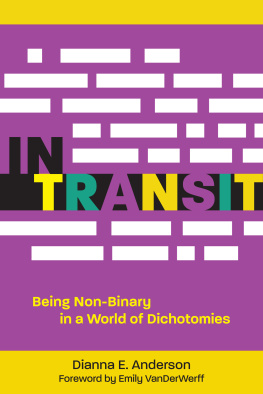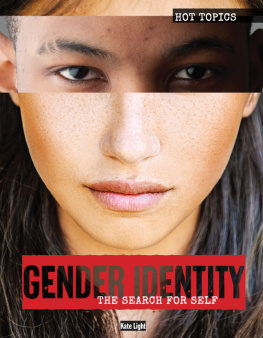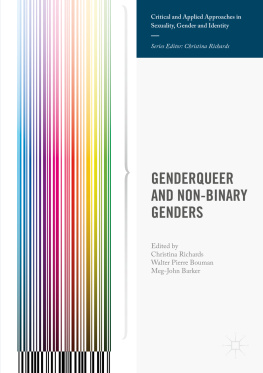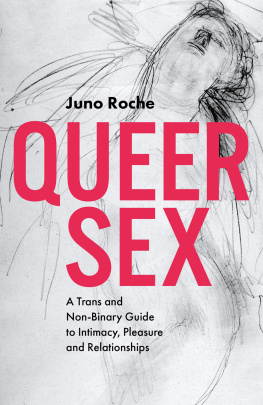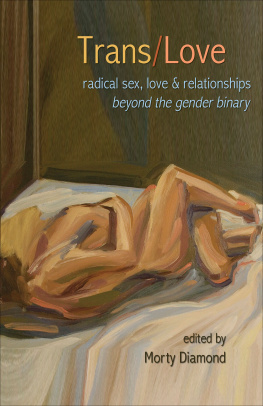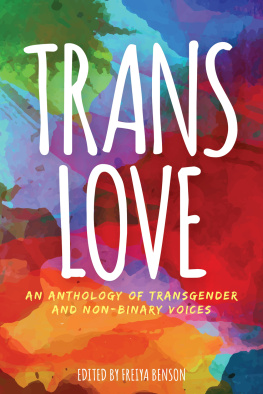Praise for In Transit
In Transit is a must-read for all audiences in pursuit of a sharper, more authentic understanding of the non-binary experience. Anderson confidently cuts through the noise of our cis-centered world, interweaving poignant accounts from queer history and outside LGBTQ+ perspectives. Above all, for those who feel displaced by dichotomies, this is a powerful, necessary reclamation of self and community.
Eugene Lee Yang, writer, director, actor, and digital producer
In Transit provides a multifaceted look at what it means to be non-binary. Dianna Anderson recounts their own personal journey while simultaneously sharing the voices and stories of non-binary people who have traveled different pathways and come to understand themselves in diverse ways. Grounded in history and theory, yet always accessible, the book is an enlightening and enjoyable deep dive into this often overlooked and misunderstood identity.
Julia Serano, author of Whipping Girl and Excluded
In Transit takes you through the history and theory behind the language that we use now to describe who we are, all while walking with Dianna Anderson in their journey to understand what that means for them. Youll find yourself captivated and educated by revealing tales throughout their life which may strike you as more familiar than you would expect regardless of where you are in the gender mosaic.
Gavin Grimm, trans activist and victor in the landmark lawsuit GavinGrimm v. Gloucester CountySchool Board
How can you explain who you areto yourself and to otherswhen language itself is in transition? In this book Anderson paints a picture of the present moment while using a framework of travel and homecoming that will feel familiar to readers. I so appreciate that they dont shy away from the complexity of a discussion that is held both within and about gender-expansive communities. I know In Transit will encourage life-giving exploration.
Austen Hartke, author of Transforming: The Bible and the Livesof Transgender Christians
Andersons In Transit is a much-needed work on non-binary identity. It is a great introductory text. Im sure Ill be using chapters, if not the whole of the book, for my classes. A combination of personal history, relayed conversations, and research, In Transit provides an accessible, friendly, smart text for anyone seeking to understand non-binary identity.
Helen Boyd, author of My Husband Betty: Love, Sex, and Life with a Crossdresser
IN TRANSIT

IN TRANSIT
Being Non-Binary in a World of Dichotomies
Copyright 2022 Dianna E. Anderson. Printed by Broadleaf Books, an imprint of 1517 Media. All rights reserved. Except for brief quotations in critical articles or reviews, no part of this book may be reproduced in any manner without prior written permission from the publisher. Email or write to Permissions, Broadleaf Books, PO Box 1209, Minneapolis, MN 55440-1209.
Unless otherwise noted, Scripture quotations are taken from the Holy Bible, New International Version, NIV. Copyright 1973, 1978, 1984, 2011 by Biblica, Inc. Used by permission of Zondervan. All rights reserved worldwide. www.zondervan.com. The NIV and New International Version are trademarks registered in the United States Patent and Trademark Office by Biblica, Inc.
Cover design: Katie Lukes
Print ISBN: 978-1-5064-7924-8
eBook ISBN: 978-1-5064-7925-5
I am the way I am. You are the way you are. In a humane society the subject would be closed. But this is not a humane society and so, this is where my story begins.
Diane Leslie Feinberg, Journal of a Transsexual, 1980
This book is dedicated to trans and gender-expansive, gender-creative kids everywhere. Continue living your truth. The world will catch up.
CONTENTS
FOREWORD
Too often, our modern, try-hard media wants to acknowledge the existence of non-binary identities to seem hip and progressive and supportive. But the actual acknowledgment sometimes smacks of marketing. Amazing, these stories suggest. A new gender has been discovered. Now we have three! It feels a little like when the addition of peanut butter M&Ms to the plain and peanut versions was treated as if a sacred mystery of the universe had been unlocked.
And, look, I know all the right things to say to explain how complicated and individual gender is, like, Gender is a vast spectrum and Believe trans people when they say who they are. But those are marketing too, sort of. I believe theyre true, but theyre things we say to gloss over how weird and complicated and yucky the process of figuring yourself out can be. Its one thing to know gender is a vast spectrum. Its another to look at that vast spectrum, point to a spot, and say, I think I belong there. And when you wind up there, you realize that spot is a vast spectrum too. Its spectrums all the way down.
Early in my own transition (hi, Emily, she/her), I had a recurring image pop into my brain in which I saw myself not as I was but as a suggestion of a person to be, a placeholder that only I knew how to make real. I used to refer to this in terms of sculpting and say I was chiseling myself out of myself. Now I would probably soften that language because it sounds really painful to be chiseled, but the idea of slowly chipping away at the parts of yourself that dont make sense until you can find the person you are is one that, I hope, applies to everybody alive, regardless of their level of comfort with their gender assigned at birth.
The thing about this work is that it takes a lifetime. Ive been living as a woman for years now, but Im still learning things about my own womanhood that I find surprising, or frustrating, or validating. Instinctively, we all know that were always evolving, but its difficult to allow for both the pain and possibility of that evolution.
Trans people know this acutely, but even I have learned so much from my non-binary and gender-fluid friends about what it means to embrace self-discovery. Thats why Im so glad this book exists. My friend Dianna takes something complicated and in need of explanation (the slipperiness of gender) and somehow explains it via further complicating it. There are no easy answers. There are only vague destinations.
My favorite tarot card is the six of swords. In its most famous depiction, a figure huddled in a boat crosses a river, a wall of swords blocking them from seeing the other shore. Its a card about going somewhere without quite knowing where that somewhere is. You can probably see why this appeals to me, a trans woman, but I think weve all felt the uncertainty of not knowing how to get there from here.
We know theres a river. We dont know whats on the other side, but we have to cross anyway. Dont listen to anyone who tells you theres only the one boat. There are as many ways to cross it as there are people. I hope this book helps you find your way across, wherever you end up.
Emily VanDerWerff, Critic at Large for Vox
September 21, 2021
INTRODUCTION
When I see birches bend to left and right
Across the lines of straight, darker trees,
I like to think some boys been swinging them.
Robert Frost, Birches
I grew up climbing trees. In my hometown of Sioux Falls, South Dakota, our house had multiple trees in the yardhuge old-growth maples and some middle-aged elm trees. The one that was easiest to get up into was also directly across from my bedroom. Id climb up three stories and look across to realize I was level with the roof of the house. For a kid notoriously anxious about heights, climbing that tree felt safe: I was sure in my hands ability to grip the branches, my legs ability to brace themselves against lower branches, and the trees sturdiness to support my back. The fact that children my age fell out of trees and hurt themselves seemed a strange fantasy to mea thing that happened in books but not in real life, because surely other children felt the grip of the tree, tested the branches, and knew how high they could go before the tree branches would bend and snap under their weight.

